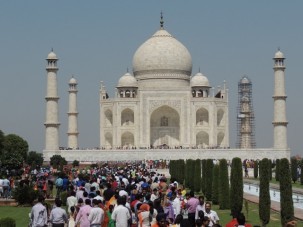Bangladesh and India, Too
Returning to Bangladesh for additional fieldwork, I stopped off in India for several meetings, but we found time for some sightseeing, too. We were able to see the Qutub Minar complex in Delhi as well as the Taj Mahal and Agra Fort in Agra. Plus all the meetings in Delhi, Kolkata and Dhaka were very successful.

I am heading back to Bangladesh, but this time I am stopping in New Delhi before heading to Bengal (West Bengal and Bangladesh). It is the first time that I will be in a part of India that is not adjacent to Bangladesh. Several of us are meeting there to plan for a new project that will span Bangladesh to India to Myanmar. I arrived a few hours before Nano Seeber and Paul Betka and used the time to get a new Indian SIM for my phone. After meeting up, we headed to the guesthouse of the Ministry of Earth Sciences, where we will be staying. If only the U.S. had a cabinet level department for earth sciences. It was difficult to find at night without a Hindi speaker, but we managed.
Over the next few days we had meetings about the project, but also some time for sightseeing, while

discussing the project in the car. Most of our meals were vegetarian, and Gandhi’s birthday, which occurred while we were there, is celebrated by eating vegetarian. When two more scientists arrived from Singapore, we started the day by visiting the Qutub Minar, dating back to the 1200s and the arrival of the Muslim Delhi Sultanate, followed by the Mughal Empire in the 1500s. In the Quwwat-ul-Islam mosque, there is the famous Iron Pillar originally erected by Chandragupta in the 4th century, probably at Patna, and brought here much later. Near the beginning of the inscription it says: “in battle with the Vanga countries, he kneaded (and turned) back with (his) breast the enemies who, uniting together came against (him).” Vanga is Bengal, now split into West Bengal in India and Bangladesh.

After mostly finishing discussions, the others decided to take a day trip to Agra to see the Taj Mahal. I was able to change my flight to Kolkata to the following morning and joined them, continuing to talk science on the 4-hour drive. We had to buy the expensive tickets at 750 rupees rather than the 10 rupees the Indians were paying. However, the premium ticket lets us bypass the long lines. The Taj Mahal is the tomb of Mumtaz Mahal,

the beloved wife of Shah Jahan, the Mughal Emperor. It was built over 17 years from 1631-1648. She died in childbirth of her 14th child. He was buried there as well when he died in 1668, after being overthrown by his son. I have seen many pictures but was not expecting how enormous the structure is. The entire place is beautiful and enormous with flanking buildings, gardens and gateways. I kept wondering about the cost of building it and how many man-years of India’s peasants financed it. Perhaps this excess was why this was the peak of the Mughal Empire. Within a 100 years, the British were

taking over. Afterwards we went to Agra Fort, which is similarly gigantic, and another seat of the Mughals. There are palaces and a throne inside the red fort with views of the Taj. There are 30 buildings left, the rest having been leveled by the British to erect barracks for their troops. We didn’t get back to our hotel until 11.
I left early the next morning for Kolkata, the British Indian capital until 1911, when they moved it to Delhi. It was done to punish the Bengalis for opposing the

splitting of the Bengal Presidency into more manageable size, which would have cut Bengal in two. I spent the day at Calcutta University then headed back to the airport to fly to Dhaka. At my usual hotel, I met up with Jenn Pickering, a student at Vanderbilt University, and Céline Grall, my postdoc. They were teaching a short course at Dhaka University. I spent the next few days in multiple meetings and making arrangements for a week of fieldwork. It will be good to get out into the countryside.

